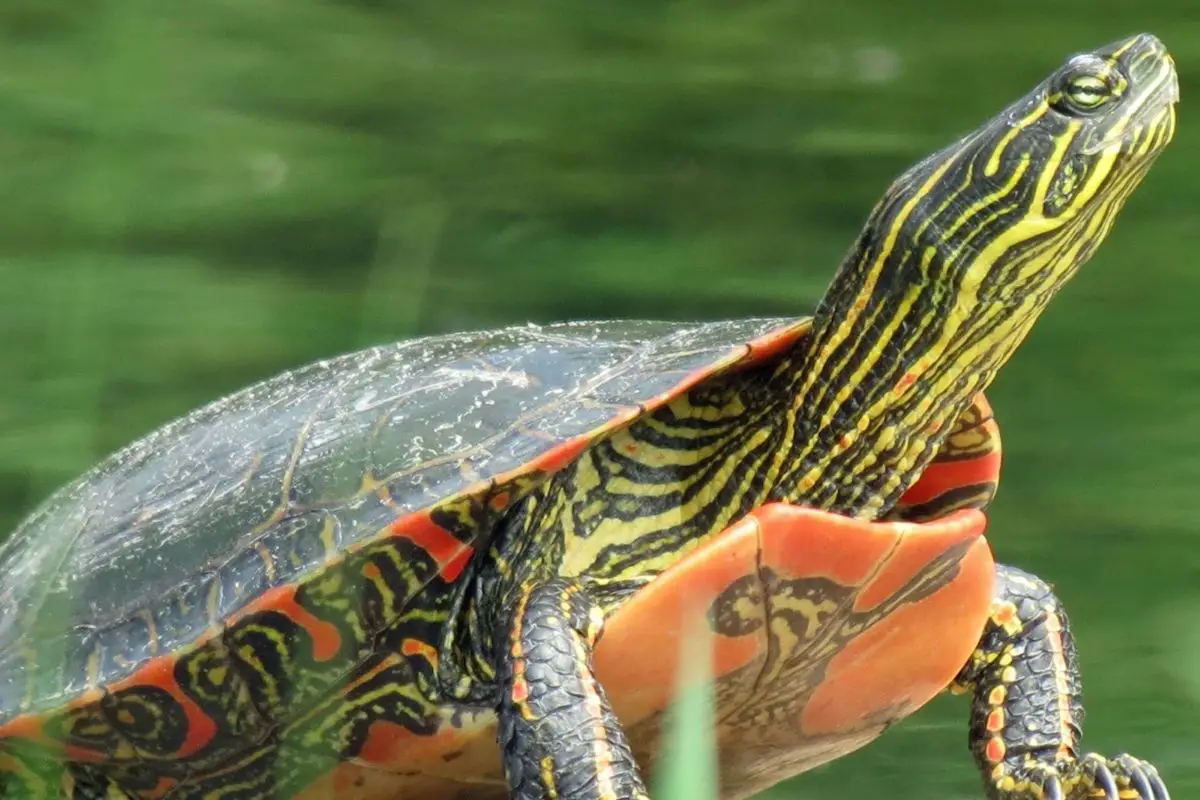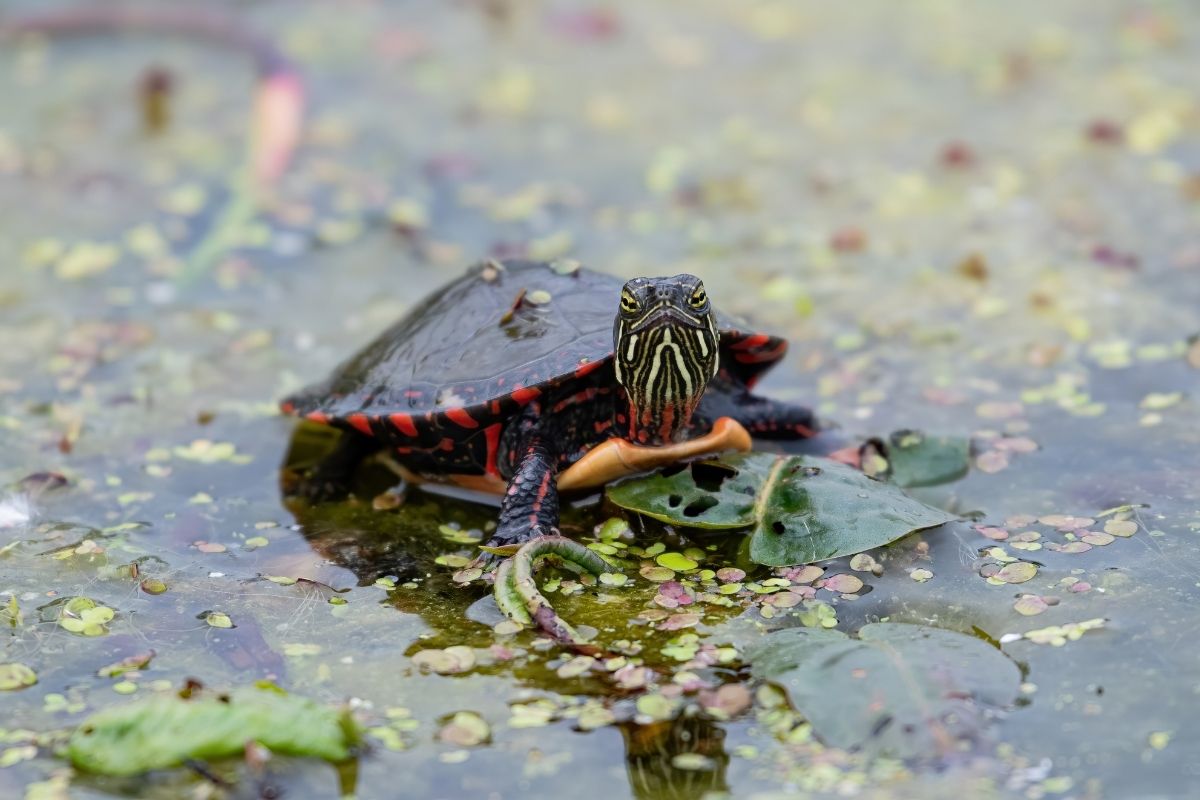Painted turtles are easily identifiable by their vivid colors and intricate shell designs.
They are one of the most common turtles to have as pets due to their bright colors as well as being relatively easy to care for. While they can be pets though, many are still found in the wild.
Painted turtles like bodies of freshwater with soft, muddy bottoms, including lakes, ponds, and streams. They like slow-moving rivers with dense vegetation and exposed locations where they may sunbathe all day.
Turtles with painted shells may be found across North America, Canada, and New Mexico.
As painted turtles can be found in a variety of locations, the species has been split into four types depending on where they live.
Here is everything you should know about painted turtles and their life in the wild.

Eastern Painted Turtles
Eastern painted turtles are found around the coast of Canada and down to Georgia, USA. Their range is mostly restricted to warm areas adjacent to the Atlantic Ocean.
These turtles often mix and mate with the midland painted turtle species, as their territories overlap in some places.
Eastern painted turtles are easily identified by their deep green shells with a weak central stripe and brilliant crimson streaks around the sides. The bottom shell is often a pale golden color.
Midland Painted Turtles
Midland-painted turtles may be found in several states in the United States, including West Virginia, Tennessee, Kentucky, Indiana, Ohio, New York, and Michigan, among others.
Within these confines, they coexist alongside southern painted turtles, who are also protected.
The painted turtle of the midland may also be found in parts of Canada such as Quebec and Ontario. It is at this location that they come face to face with their painted turtle cousins.
Midland-painted turtles should be in bodies of water that are calm and slow-moving. They are usually found around shallow-watered coastlines and coves that are densely vegetated.
Southern Painted Turtles
Though the territories of midland and southern painted turtles overlap slightly, Southern painted turtles are far more common in the southern states of the USA.
They are spread across a huge area and can be found in western Tennessee, Northern Mississippi, Alabama, Oklahoma, Texas, Missouri, and southern Illinois.
Southern painted turtles, like midland turtles, like calm, peaceful waters. They like slow-moving streams and densely forested environments.
Western Painted Turtles
Western painted turtles are located in Western Canada’s southernmost areas. Due to geographical restrictions, they can’t mix or see their midland painted turtle counterparts.
As well as Canada, they are present in British Columbia and the bulk of Central American States. These turtles can live in almost any body of freshwater comfortably, including roadside pools so long as they are big enough.
You can also find them in agricultural ponds, regular ponds, and streams. The shell of the Western painted turtle is intricately decorated with mesh-like patterns.
The underside shell is speckled with a brightly colored blotch that continues toward the legs. This turtle matures at a faster rate than the other painted turtle species.
Painted Turtle Habitat
Painted turtles are an aquatic variety of turtle, though they do not spend their whole life in the water. While they do spend most of their time in the water they emerge to bask in the sun on rocks or logs on occasion to keep themselves warm.
In the wild, painted turtles are found in freshwater habitats with slow-moving water. They are more comfortable in shallow water such as pools, marshes, streams, or lakes than in deeper bodies of water.
Painted turtles are also occasionally observed in salty marshlands and brackish water. Turtles go toward areas of water with a soft mud bottom. Additionally, they like areas with logs and climbable rocks.
Turtles with painted shells love dense vegetation. It offers them a variety of hiding spots. Burrowing into the dirt and covering themselves in grass and leaves, the animals conceal themselves to hide from predators.
Due to their cold-blooded nature, painted turtles rely on the sun to maintain a steady body temperature. They hibernate in the winter months when the ambient temperature drops.
Burrowing into the mud, painted turtles hibernate until the weather warms sufficiently for them to find food.
While painted turtles cluster in groups sometimes, they are loners at heart. They are not particularly social creatures and like to spend most of their time alone.
Despite this, once a year they will gather in an area for the mating season. After this though, they all go their separate ways to spend the rest of the year alone.
Where Do Painted Turtles Live In Winter?

A painted turtle is active throughout the summer. Due to its dependency on its surroundings and the sun for warmth, throughout the winter when the temperature drops they become lethargic and inactive.
Almost all wild-painted turtles spend the winter in hibernation. The turtles forage throughout the spring and summer but quit feeding altogether in the fall. When the temperature lowers, the turtle prepares to hibernate.
Painted turtles prefer peaceful regions where they may remain concealed in peace. The best areas for painted turtles to hibernate in are areas with a lot of dense vegetation, along the edge of a beach, or at the very bottom of a pond.
You may be surprised to learn that during hibernation, painted turtles don’t breathe at all. This is because to do this, they would have to swim to the surface, and it would be too cold for them to do so.
Instead of regular breathing, during hibernation, a painted turtle absorbs oxygen found in the water through their skin to keep them alive.
Where Do Baby Turtles Live?
Painted turtles have one breeding season a year, which runs from March to mid-June. Fertilized females ascend to the coast to deposit their eggs.
They will build nests like flasks to shelter their eggs. In quest of the optimal nesting place, older females frequently move further inland than young females.
The egg-laying season typically lasts from May through July. The turtle insulates the nest with layers of soil after creating the hole and depositing the eggs.
After laying her eggs, the female turtle stays in this area until she regains the strength to return to the water. After that, the eggs are left to their own devices.
Painted turtle eggs hatch three months after being laid usually. The temperature of the nest will determine the gender of the young. Females are born in warmer nests, whereas males are born in cooler nests.
Typically, hatchlings spend the fall and winter in the nest and then migrate to the water in the spring. Like the grown-ups, baby turtles prefer to live in slow-moving fresh water like ponds and streams. They quickly integrate into an area’s existing turtle colony and adapt to their new environment.
Painted Turtles Characteristics
Painted turtles may be found in large numbers all across North America. Their most distinguishing feature is the bright coloration of their skin and shells.
Their skin is wonderfully striped in colors of red, yellow, and orange, and the color of their shell is often olive-green. The shells of these turtles are smooth and devoid of ridges.
Painted turtles are fairly little, reaching up to 25 centimeters in length on average. They are scavengers and opportunistic omnivores who eat everything they can get their hands on.
The majority of their food consists of plants and tiny animals, which they consume in large quantities. Crabs and fish are among the aquatic invertebrates that they prey on. Aside from that, they consume any insects that have fallen into the water.
Additionally, they will devour algae and other plants that are found in their native environment to supplement their diet.
Each of the four types of painted turtle is somewhat different in look and size. They may, however, interbreed, producing what are known as intergrades.
Painted turtles are most active during the daylight hours and remain dormant during the nighttime hours of darkness. Painting turtles are aquatic species that spend a large amount of their time sunbathing on a rock or branch just outside of the water’s surface.
Painted turtles frequently nest atop one another to catch some rays, despite the fact that they are not very fond of benign social interaction with one another. They are stacked on top of one another to get the most solar exposure and warmth possible.
They benefit from exposure to the sun because it provides them with the UV rays that are essential for metabolism.
Additionally, this exercise contributes to the formation of Vitamin D, which is essential for maintaining good health and well-being
Summary
Painted turtles can be found in many places around both Canada and the United States. While all of these turtles are the same species, they have slight variations depending on where they live.
All painted turtles thrive in warm, freshwater though, and can commonly be found in slow streams, rivers, or ponds.
